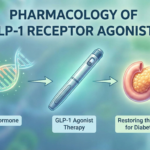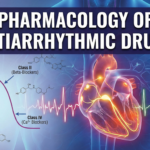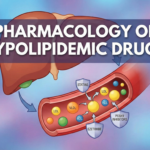Antiarrhythmic drugs are used to treat various types of abnormal heart rhythms (arrhythmias). They are classified into four main classes (Class I, II, III, and IV) according to the Vaughan-Williams classification system. This system is based on its primary mechanism of action and electrophysiological effects on the heart.
Examples
- Class IA: Quinidine, Procainamide, Disopyramide
- Class IB: Lidocaine, Mexiletine, Phenytoin
- Class IC: Flecainide, Propafenone
Mechanism of action: Class I drugs block the fast sodium channels, slowing down the rate of depolarization and the conduction velocity in the heart.
Pharmacological actions: Class IA drugs prolong the action potential duration and effective refractory period. Class IB drugs shorten the action potential duration and effective refractory period. Class IC drugs have minimal effects on the action potential duration and effective refractory period.
Uses: These drugs are used to treat various types of supraventricular and ventricular arrhythmias.
Adverse effects: Dizziness, nausea, blurred vision, heart block, and proarrhythmia.
Contraindications: Severe heart block, recent myocardial infarction, or severe heart failure.
Drug interactions: These drugs may interact with other antiarrhythmic drugs, anticoagulants, and some antihypertensive medications.
Examples: Propranolol, Metoprolol, Atenolol
Mechanism of action: These drugs block beta-adrenergic receptors, reducing sympathetic stimulation to the heart.
Pharmacological actions: They decrease heart rate, contractility, and conduction velocity, and increase the atrioventricular (AV) nodal refractory period.
Uses: Supraventricular arrhythmias, ventricular arrhythmias, and prevention of recurrent myocardial infarction.
Adverse effects: Bradycardia, hypotension, fatigue, and bronchospasm.
Contraindications: Severe bradycardia, heart block, and decompensated heart failure.
Drug interactions: Calcium channel blockers, digoxin, and other antiarrhythmic drugs.
Class III: Potassium channel blockers
Examples: Amiodarone, Sotalol, Dofetilide
Mechanism of action: These drugs block the rapid delayed rectifier potassium channels, prolonging the action potential duration and the effective refractory period.
Pharmacological actions: They increase the action potential duration and effective refractory period in cardiac tissues, which may help to terminate reentrant arrhythmias.
Uses: Ventricular and supraventricular arrhythmias, especially atrial fibrillation.
Adverse effects: Amiodarone has many side effects, including pulmonary toxicity, liver toxicity, and thyroid dysfunction. Other side effects include dizziness, nausea, and QT interval prolongation.
Contraindications: Severe bradycardia, heart block, and electrolyte imbalances.
Drug interactions: Anticoagulants, antiarrhythmic drugs, and certain anti-infective agents.
Class IV: Calcium channel blockers
Examples: Verapamil, Diltiazem
Mechanism of action: These drugs block L-type calcium channels in the heart, slowing down the rate of depolarization and conduction velocity.
Pharmacological actions: They slow AV nodal conduction and increase the AV nodal refractory period.
Uses: Supraventricular arrhythmias, especially atrial fibrillation and atrial flutter.
Adverse effects: Hypotension, bradycardia, Hypotension, bradycardia, heart block, constipation, and dizziness.









